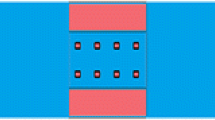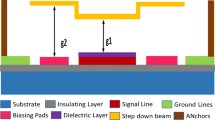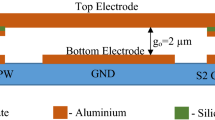Abstract
In this paper, two types of RF MEMS switches namely step structure and Normal beam structure are designed and analyzed using different meander techniques. Three techniques namely plus, zigzag and three-square meander were used to lower the pull-in voltage. The actuating beam is designed with the rectangular perforations affects the performance of a switch by lowering the pull-in voltage, switching speed and results in better isolation. In this paper a comparative analysis is done for all three meander techniques with and without perforations on the beam. Total six structures have been designed with the combination three meanders and two different beam structures. The proposed stepdown structure exhibits high performance characteristics with a very low pull-in voltage of 1.2 V having an airgap of 0.8 µm between the actuation electrodes. The gold is used as beam material and HfO2 as the dielectric material such that the upstate and downstate capacitance is seen as 1.02 fF and 49 fF. The FEM analysis is done to calculate the spring constant and thereby the pull-in voltage and behavior of the switch is studied with various parameters. The switch with a step structure and three-square meander configuration has shown best performance of all by requiring a pull-in voltage of 1.2 V and lower switching time of 0.2 µs. The proposed switch also exhibits good RF performance characteristics with an insertion loss below − 0.07 dB and return loss below − 60 dB over the frequency range of 1–40 GHz. At 28 GHz a high isolation of − 68 dB is exhibited.





























Similar content being viewed by others
References
Angira M, Rangra K (2015) Design and investigation of a low insertion loss, broadband, enhanced self and hold down power RF-MEMS switch. Microsyst Technol 21(6):1173–1178
Bachman M, Yang Z, Minfeng W, Li G (2012) High-power magnetically actuated microswitches fabricated in laminates. IEEE Electron Device Lett 33(9):1309–1311
Balaraman D, Bhattacharya SK, Ayazi F, Papapolymerou J (2012) Low-cost low actuation voltage copper RF MEMS switches. IEEE Microw Theory Tech Symp 2:1225–1228
Chakraborty A, Gupta B, Sarkar BK (2014) Design, fabrication and characterization of miniature RF MEMS switched capacitor based phase shifter. J Microelectron 45:1093–1102
Fedder GK (1994) Simulation of micro-electro-mechanical systems. Ph.D. Dissertation, Electrical Engineering and Computer Science, University of California at Berkeley, USA
Guha K, Kumar M, Parmar A, Baishya S (2016) Performance analysis of RF MEMS capacitive switch with non-uniform meandering technique. Microsyst Technol 22(11):2633–2640
He X, Lv Z, Liu B, Li Z (2011) Electro thermally actuated RF MEMS capacitive switch with automatic layer deposited (ALD) dielectrics. In: 16th international conference on solid-state sensors, actuators and microsystems conference, (RANDUCERS), pp 2470–2473
Jaspreet MH et al (2014) Methods for the minimization of actuation voltage in MEMS. Int J Eng Res Appl 4(3):23–27
Katehi LPB, Harvey JF, Brown E (2002) MEMS and Si micromachined circuits for high frequency applications. IEEE Trans Microw Theory Tech 50(3):858–866
Kumar PA, Sravani KG, Sailaja BVS, Vineetha KV, Guha K, Rao KS (2018) Performance analysis of series: shunt configuration-based RF MEMS switch for satellite communication applications. Microsyst Technol. https://doi.org/10.1007/s00542-018-3907-1
Lee J, Yang WS, Kang S, Choi CA (2015) Design and parameter extraction based small-signal modelling of a novel centre-anchor MEMS series switch. In: Proceedings of the 34th European Microwave Conference, Amsterdam, The Netherlands, pp 1433–1436
Marcelli R, Lucibello A, De Angelis G, Proietti E, Comastri D (2010) Mechanical modelling of capacitive RF MEMS shunt switches. Microsyst Technol 16:1057–1064
Molaei S, Ganji BA (2017) Design and simulation of a novel RF MEMS shunt capacitive switch with low actuation voltage and high isolation. Microsyst Technol 23(6):1907–1912
Öjefors E (2004) Micromachined antennas for integration with silicon based active devices. Uppsala University, Uppsala
Papapolymerou I, Drayton RF (1998) Micro machined patch antennas. IEEE Trans Antennas Propag 46(2):275–283
Ramli N, Sidek O (2012) Reducing an actuation voltage of RF MEMS capacitive switch through three electrodes topology using architect conventorware. J Eng Technol 2(2):46–51
Rao KS, Sravani KG (2018) Design and performance analysis of uniform meander structured RF MEMS capacitive shunt switch along with perforations. Microsyst Technol 24(2):901–908
Rebeiz GM (2003) RF MEMS: theory, design and technology, 3rd edn. Wiley, Hoboken
Roark RJ, Young WC (1989) Formulas for stress and strain, 6th edn. McGraw-Hill, New York
Sharma A, Shah A, Bharti R (2015) Design and simulation of low actuation voltage perforated shunt RF MEMS switch. Int J Eng Tech Res 3(6):236–242
Sravani KG, Rao KS (2018) Analysis of RFMEMS Shunt capacitive switch with uniform and non uniform meanders. Microsyst Technol 24(2):1309–1315
Verma P, Singh S (2013) Design and simulation of RF MEMS capacitive type shunt switch and its major applications. J Electr Commun Eng 4(5):60–68
Acknowledgements
The Authors would like to thank to NMDC supported by NPMASS, National Institute of Technology, Silchar for providing the necessary computational tools.
Author information
Authors and Affiliations
Corresponding author
Additional information
Publisher's Note
Springer Nature remains neutral with regard to jurisdictional claims in published maps and institutional affiliations.
Rights and permissions
About this article
Cite this article
Sravani, K.G., Guha, K. & Rao, K.S. Analysis of a novel RF MEMS switch using different meander techniques. Microsyst Technol 26, 1625–1635 (2020). https://doi.org/10.1007/s00542-019-04703-w
Received:
Accepted:
Published:
Issue Date:
DOI: https://doi.org/10.1007/s00542-019-04703-w




